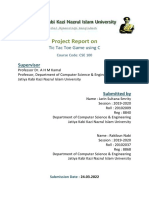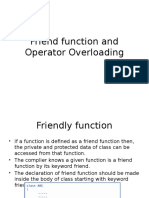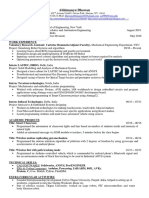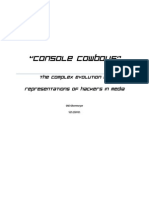Lab Manual: Oop With C++
Lab Manual: Oop With C++
Uploaded by
Abhilash SRIRAMULAOriginal Title
Copyright
Available Formats
Share this document
Did you find this document useful?
Is this content inappropriate?
Report this DocumentCopyright:
Available Formats
Lab Manual: Oop With C++
Lab Manual: Oop With C++
Uploaded by
Abhilash SRIRAMULACopyright:
Available Formats
C++ Lab Manual www.cranesvarsity.
com
ty
Lab Manual
Oop with C++
rsi
Va
es
an
Cr
© Cranes Varsity V2.1-2018-19 1/ 12
C++ Lab Manual www.cranesvarsity.com
SECTION -I
CHAPTER - 1
INTRODUCTION TO OBJECT ORIENTED PROGRAMMING
1. A lift can accept a maximum load of 1000kg. WAP to check how many people enter lift & what is the
total weight currently present in the lift? If it exceeds maximum limit, set a variable for overweight. If
overweight variable is set ring alarm.
2. Write a function Open_account () which will open an account for you in a bank. Decide what should
be the arguments for this functions & which arguments can take default values. Also decide which
arguments should be put in leading end & which one should be put in trailing end.
ty
3. A namespace ‘Garden; has a structure ‘Tree’. A namespace ‘Forest’ has a structure tree. Put
appropriate data’s within each structure. In main, create variables of each structure and access data
rsi
members within each structure.
CHAPTER - 2
PROCEDURAL APPROACH IN C++ Va
1. Write a C++ program that will display the calculator menu.
2. Write a C++ program (using function overloaded) to sort 10 integer values, or 10 float values, or 10
double values?
3. Write a function ‘Toggle_Bit’ to toggle a particular bit of a number. From main, invoke this function.
es
After that print the number in main. The changes should be reflected.
4. Raising a number to a power p is the same as multiplying n by itself p times. Write a function called
power that takes two arguments, a double value for n and an int value for p, and return the result as
an
double value. Use default argument of 2 for p, so that if this argument is omitted the number will be
squared. Write the main function that gets value from the user to test power function.
5. Write a function called zero_small() that has two integer arguments being passed by reference and
Cr
sets the smaller of the two numbers to 0. Write the main program to access the function.
CHAPTER - 3
OBJECT ORIENTED APPROACH IN C++
1. Define a class BOOK with the following specifications :
Private members of the class BOOK are
BOOK NO integer type
BOOKTITLE 20 characters
© Cranes Varsity V2.1-2018-19 2/ 12
C++ Lab Manual www.cranesvarsity.com
PRICE float (price per copy)
TOTAL_COST() A function to calculate the total cost for N number of copies where N is passed
to the function as argument.
Public members of the class BOOK are
INPUT() function to read BOOK_NO. BOOKTITLE, PRICE
PURCHASE() function to ask the user to input the number of copies to be purchased. It
invokes TOTAL_COST() and prints the total cost to be paid by the user.
Note : You are also required to give detailed function definitions.
2. Write the definition for a class called complex that has floating point data members for storing real
and imaginary parts. The class has the following member functions:
void set(float, float) to set the specified value in object
void disp() to display complex number object
ty
complex sum(complex) to sum two complex numbers & return complex number
1. Write the definitions for each of the above member functions.
2. Write main function to create three complex number objects. Set the value in two objects and call
sum() to calculate sum and assign it in third object. Display all complex numbers.
rsi
3. Create a class called Cylinder. This should provide member functions to :
a. Set the radius & height of the Cylinder
b. Calculate the volume of Cylinder ( pi*r*r*h)
c. Calculate the Area of the Cylinder ( 2 *pi *r *(r+ h) )
Va
In main, create object for the above class and show the operations.
4. Create a class Employee. Add appropriate data & functions inside class. Show the three applications
of “this” pointer
es
CHAPTER - 4
CLASS INTERNALS – CONSTRUCTORS AND DESTRUCTORS
1. Consider the definition of the following class:
an
class Sample
{
private:
int x;
double y;
public :
Cr
Sample(); //Constructor 1
Sample(int); //Constructor 2
Sample(int, int); //Constructor 3
Sample(int, double); //Constructor 4
};
i. Write the definition of the constructor 1 so that the private member variables are initialized to 0.
ii. Write the definition of the constructor 2 so that the private member variable x is initialized according to
the value of the parameter, and the private member variable y is initialized to 0.
© Cranes Varsity V2.1-2018-19 3/ 12
C++ Lab Manual www.cranesvarsity.com
iii. Write the definition of the constructors 3 and 4 so that the privatemember variables are initialized
according to the values of the parameters.
2. Dynamically create an array of 10 integers. Assign value of 0 to 9 in the allocated array. Print values of
the array. After that delete the array.
3. Write a class called Building. Add default constructor and parameterized constructor to it. Create two
objects in main. Make first object to invoke default constructor & second object to invoke
parameterized constructor.
4. In question 2, add a data member ‘location of building’ which is of the type char *. Dynamically
allocate memory for ‘location’ in constructors. Add destructors to de-allocate heap memory. Create two
ty
objects in main dynamically. Make first object to invoke default constructor & second object to invoke
parameterized constructor.
5. In question 3, create object which invokes copy constructor provided by the compiler. Analyze the
rsi
output. Then add user defined copy constructor which is doing deep copy & again analyze the output.
CHAPTER - 5
CLASS INTERNALS – STATIC AND CONSTANTS IN C++
Va
1. Create a class My_Account . Put suitable data members & member functions as static. Prove that
static data member comes into existence even before creating an object.
es
2. In class My_Account make appropriate data members & member functions as constant .Create a non
constant object , a constant object & try to find out which member functions can be invoked by these
objects .
a. WAP to count number of objects created for a class My_Account.
an
Hint: use static data member as count.
3. In a company, all the systems are connected in LAN. All the systems share a printer. When a system
is trying to print, it sets a variable ‘Printer _status’. When printing is over , Printer_status is reset. All
the systems have unique name which cannot be modified. Having this information, decide what data
Cr
members & member functions can be added. Also decide, out of these, which members can be made
as static and constant.
4. WAP to create a class called Human. The class should have at least five data & function members, of
which two data members should be static. The functions should perform actions specific to activities in
day to day life of humans. Check if there are any places where one can make use of static member
functions.
© Cranes Varsity V2.1-2018-19 4/ 12
C++ Lab Manual www.cranesvarsity.com
CHAPTER - 6
OPERATORS OVERLOADING & FRIEND KEYWORD
1. Design a class called My_String which represent a C++ string (denoted by char*). Overload
following operators in the class :
1. operator + which concatenates two strings
(Usage example: My_String + My_string, or My_String + char*)
2. Operator == to compare strings
3. Operator = to assign one string to another
ty
4. Operator! = to compare two strings
2. Create a class Shopping_list which has data member price [10] which stores prices of 10 items
purchased by a person.
rsi
1) Overload Operator [] to store the price of item specified by position.
2) Assume that the calculator has some problem while entering the data for price It takes one
rupee less than actual cost. Now overload ++ operator to increment the price of each item as
well as to get the total price for the whole shopping.
Va
3. Create a class called Distance which has data members as foot & inch. Write constructors to initialize
the data members. Overload ( ) operator to assign values to foot & inch. Add member functions to
return distance in inch. Create objects in main and invoke all the member functions.
CHAPTER - 7
GENERIC PROGRAMMING
es
1. Create a vector and read a list of names of fruits from cin into it. Sort the list and print it.
2. Create an object of class STL Vector. Insert 10 elements into vector. Assign values to 10 elements,
an
Then add 10 more elements to vector. Then Insert 10 times value 100 from positon 2, Finally, Erase
the values inserted. After each and every operation mentioned, print the contents of vector.
3. Produce a vector of squares of numbers 1 through 100. Print a table of squares. Take the square root
of the elements of that vector and print the resulting vector
Cr
4. Create a list and Sort it using only standard library algorithms.
5. Create a map named Employee with their name and id. Make use of array assignment to add the new
employees. Display the map. Write a code to remove the particular employee from the map and then
display it again.
CHAPTER – 8
GENERALIZATION - INHERITANCE
© Cranes Varsity V2.1-2018-19 5/ 12
C++ Lab Manual www.cranesvarsity.com
1. Implement a single inheritance program where base class is Clock & derived class is Alarm_Clock .
Base class should have at least one member with private access, one member with protected access,
one with public access. Clearly differentiate between different access specifiers. While designing
classes make sure you add valid data members & member functions. Also try to analyze the difference
between private, public & protected mode of inheritance.
2. In Q1, add default as well as parameterized constructors in both base & derived class. Create object
of Alarm_Clock class. Make it to call parameterized constructors of base as well as derived. Add
destructors also. Check the order of destructors when derived class object goes out of scope.
3. WAP to create a class called Math. Derive Geometry, Arithmetic & Algebra from it. Add
functionalities specific to these branches of Math to each of these derived classes. Perform
operations and reflect the last updated values in all the classes.
ty
4. WAP to implement multilevel inheritance
rsi
Mammal
Person
Va
Educated_Person
es
Add default constructor, parameterized constructor as well as destructor in all the classes. Create
object of Educated_Person class check the order of constructors & destructors.
5. WAP to implement hybrid inheritance. Remove the death of diamond problem.
an
Animal
Cr
Water_Animal
Land_Animal
Amphibian
© Cranes Varsity V2.1-2018-19 6/ 12
C++ Lab Manual www.cranesvarsity.com
CHAPTER - 9
RUN TIME POLYMORPHISM
Shape
Rectangle Circle
ty
1. For the above mentioned hierarchy, implement Hierarchical inheritance. Shape class has one
member function ‘draw’, override this function in Rectangle class and Circle class. Create object of
Rectangle class and Circle class and invoke function draw. Analyze which function is invoked.
rsi
2. For the class implemented in Q1, now create Shape class pointer
a) Make it to hold address of Shape class object, invoke draw function.
b) Make it to hold address of Circle class object, invoke draw function.
c) Make it to hold address of Rectangle class object, invoke draw function.
Va
Analyze which functions are being called.
Now make ‘draw’ function virtual in Shape class. Follow steps a ,b, c . Analyze
which functions are being called. Find out reason for different outputs.
3. For the above class diagram , show the need for virtual destructor.
es
4. Given the class
class AbstractString
{
an
public:
virtual void display ( ) = 0;
..........
};
Derive the classes : UpperString and LowerString .
Cr
Implement display( ) function to print the characters in the appropriate upper or lower cases.
Have a menu driven program allowing the user to enter the choice and display the characters in the
appropriate case .Use appropriate data members in the base class which would be required in the
derived classes. Implement dynamic binding.
SECTION -II
Specify the output of the following codes:
Question 1:
#include<iostream>
using namespace std;
© Cranes Varsity V2.1-2018-19 7/ 12
C++ Lab Manual www.cranesvarsity.com
class Base
{
protected:
int x;
public:
Base (int i){ x = i;}
};
class Derived : public Base
{
public:
Derived (int i):x(i) { }
void print() { cout << x ; }
};
ty
int main()
{
Derived d(10);
d.print();
rsi
}
Question 2:
#include <iostream>
using namespace std;
class Base {
Va
virtual void method() {std::cout << "from Base" << std::endl;}
public:
es
virtual ~Base() {method();}
void baseMethod() {method();}
};
an
class A : public Base {
void method() {std::cout << "from A" << std::endl;}
public:
~A() {method();}
Cr
};
int main(void) {
Base* base = new A;
base->baseMethod();
delete base;
return 0;
}
Question 3:
© Cranes Varsity V2.1-2018-19 8/ 12
C++ Lab Manual www.cranesvarsity.com
#include <iostream>
using namespace std;
class A
{
public:
void print() { cout << "A::print()"; }
};
class B : private A
{
public:
void print() { cout << "B::print()"; }
};
class C : public B
ty
{
public:
void print() { A::print(); }
};
rsi
int main()
{
C b;
b.print();
}
Va
Question 4:
#include <iostream>
using namespace std;
class A
es
{
int id;
public:
A (int i) { id = i; }
void print () { cout << id << endl; }
an
};
int main()
{
A a[2];
a[0].print();
Cr
a[1].print();
return 0;
}
Question 5:
#include<iostream>
using namespace std;
class Test {
int value;
public:
Test (int v = 0) {value = v;}
© Cranes Varsity V2.1-2018-19 9/ 12
C++ Lab Manual www.cranesvarsity.com
int getValue() { return value; }
};
int main() {
const Test t;
cout << t.getValue();
return 0;
}
Question 6:
#include<iostream>
using namespace std;
class Test1
ty
{
int x;
public:
void show() { }
rsi
};
class Test2
{
int x;
public:
};
virtual void show() { }
Va
int main(void)
{
cout<<sizeof(Test1)<<endl;
es
cout<<sizeof(Test2)<<endl;
return 0;
}
Question 7:
an
#include<iostream>
using namespace std;
class A
{
public:
virtual void fun() {cout << "A" << endl ;}
Cr
};
class B: public A
{
public:
virtual void fun() {cout << "B" << endl;}
};
class C: public B
{
public:
virtual void fun() {cout << "C" << endl;}
};
© Cranes Varsity V2.1-2018-19 10/ 12
C++ Lab Manual www.cranesvarsity.com
int main()
{
A *a = new C;
A *b = new B;
a->fun();
b->fun();
return 0;
}
Question 8:
#include<iostream>
using namespace std;
/* local variable is same as a member's name */
class Test
ty
{
private:
int x;
public:
rsi
void setX (int x) { Test::x = x; }
void print() { cout << "x = " << x << endl; }
};
int main()
{
Test obj;
int x = 40;
Va
obj.setX(x);
obj.print();
return 0;
}
es
Question 9:
#include <iostream>
using namespace std;
an
int fun(int a, int b = 1, int c =2)
{
return (a + b + c);
}
int main()
Cr
{
cout << fun(12, ,2);
return 0;
}
Question 10:
#include <iostream>
using namespace std;
class A
{
© Cranes Varsity V2.1-2018-19 11/ 12
C++ Lab Manual www.cranesvarsity.com
int id;
static int count;
public:
A()
{
count++;
id = count;
cout << "constructor called " << id << endl;
}
~A()
{
cout << "destructor called " << id << endl;
}
};
ty
int A::count = 0;
int main()
{
rsi
A a[2];
return 0;
}
Va
es
an
Cr
© Cranes Varsity V2.1-2018-19 12/ 12
You might also like
- Writing For Software DevelopersDocument385 pagesWriting For Software DevelopersR100% (1)
- BCS402 MC Lesson PlanDocument2 pagesBCS402 MC Lesson Plansusheela Nataraju100% (1)
- MIE Expert Nomination Questions 2021-2022Document9 pagesMIE Expert Nomination Questions 2021-2022CharleneNo ratings yet
- Structured Cyber Security CISSP BrainmapsDocument50 pagesStructured Cyber Security CISSP BrainmapsHaseeb Nasir AliNo ratings yet
- Syllabus: Module 3A-Transducers & PLCDocument24 pagesSyllabus: Module 3A-Transducers & PLCRaja G VNo ratings yet
- Microcontroller Notes MODULE 1Document49 pagesMicrocontroller Notes MODULE 1Sri Janani100% (2)
- 17ec563 M01Document28 pages17ec563 M01mohamed036100% (1)
- ComputerNetworksLAB 18ECL76 7thsemesterDocument94 pagesComputerNetworksLAB 18ECL76 7thsemesterPhanindra ReddyNo ratings yet
- Path SensitizationDocument34 pagesPath Sensitizationvinovictory8571100% (1)
- Arduino Lab ManualDocument41 pagesArduino Lab Manualvasudevanandhasrividya16No ratings yet
- MicroCont LabManual UpdatedDocument53 pagesMicroCont LabManual Updatedrishitej811No ratings yet
- Vlsi Design: III B. Tech II Semester Regular Examinations, April/May - 2019Document4 pagesVlsi Design: III B. Tech II Semester Regular Examinations, April/May - 2019pawan100% (1)
- 21EC654 Model Question Papers-1Document3 pages21EC654 Model Question Papers-1Srikanth Raja100% (1)
- HDL Lab ManualDocument72 pagesHDL Lab Manualshubham100% (1)
- Introduction To Python Programming: Text Book: Core Python Programming, Wesley J. Chun, Second Edition, PearsonDocument28 pagesIntroduction To Python Programming: Text Book: Core Python Programming, Wesley J. Chun, Second Edition, Pearsonvikhyath ReddyNo ratings yet
- Technical Seminar Circular 2023Document1 pageTechnical Seminar Circular 2023gokul dasNo ratings yet
- LPC2148 User GuideDocument58 pagesLPC2148 User GuideRishabVenkataramanNo ratings yet
- M S Engineering College: HDL Lab ManualDocument78 pagesM S Engineering College: HDL Lab Manualvivek jNo ratings yet
- Alarm Clock Using VerilogDocument5 pagesAlarm Clock Using VerilogRadhikaNo ratings yet
- Vlsi Lab Manual 17ecl77 2020 SaitDocument157 pagesVlsi Lab Manual 17ecl77 2020 Saitsuraj jha100% (1)
- Module 1 PDFDocument33 pagesModule 1 PDFKetan Janai100% (1)
- DIP Lab Manual FinalDocument31 pagesDIP Lab Manual Finalsamay guptaNo ratings yet
- Vishveshwarya Technological University BELAGAVI - 590018.: A Mini Project Report OnDocument35 pagesVishveshwarya Technological University BELAGAVI - 590018.: A Mini Project Report OnSoul ReaperNo ratings yet
- Advantages and Disadvantages MPDocument5 pagesAdvantages and Disadvantages MPVidhya AigalNo ratings yet
- 5th Sem DSP Lab ManualDocument107 pages5th Sem DSP Lab ManualHemanth KumarNo ratings yet
- VLSI Lab Manual V Sem July16Document65 pagesVLSI Lab Manual V Sem July16Aditya RanjanNo ratings yet
- Project Report On Tic Tac Toe Game Using JavaDocument15 pagesProject Report On Tic Tac Toe Game Using JavaAbuNo ratings yet
- Digital Design Through Verilog HDL Course Outcomes For LabDocument1 pageDigital Design Through Verilog HDL Course Outcomes For LabSyed AshmadNo ratings yet
- 1-32-Bit Microprocessor - Intel 80386Document37 pages1-32-Bit Microprocessor - Intel 80386afzal_a67% (3)
- ESDL Lab ManualDocument7 pagesESDL Lab Manualanbhute3484No ratings yet
- Data Structure Using C Lab (KCS351) : Programming Language/Tool Used: C and MappleDocument1 pageData Structure Using C Lab (KCS351) : Programming Language/Tool Used: C and MappleSanjay GuptaNo ratings yet
- FORMAT FOR 6th SEMESTER BTECH SYNOPSISDocument4 pagesFORMAT FOR 6th SEMESTER BTECH SYNOPSISMahima DewanganNo ratings yet
- 21CS43 Microcontroller and Embedded SystemsDocument4 pages21CS43 Microcontroller and Embedded SystemsNikhil chandNo ratings yet
- Last Minute Revision Notes For C++Programming ExamDocument33 pagesLast Minute Revision Notes For C++Programming ExamAjeet BhartiNo ratings yet
- Bcs302 Complete NotesDocument179 pagesBcs302 Complete NotesSwetha ManjunathaNo ratings yet
- Digital Lab VIVA QuestionsDocument4 pagesDigital Lab VIVA QuestionsAnirudhan RaviNo ratings yet
- Ed & I Lab 18ecl37 ManualDocument29 pagesEd & I Lab 18ecl37 Manualcharan mNo ratings yet
- AICTE Embedded Developer Internship 18042023Document1 pageAICTE Embedded Developer Internship 18042023Shanmukh VegiNo ratings yet
- Pipelining VerilogDocument26 pagesPipelining VerilogThineshNo ratings yet
- Elementary Data Link ProtocolsDocument61 pagesElementary Data Link ProtocolsRekha V RNo ratings yet
- Pyhton FunctionsDocument22 pagesPyhton FunctionsKHUSHI JAINNo ratings yet
- Becl305 Adsd Lab ManualDocument81 pagesBecl305 Adsd Lab ManualSakshi HiremathNo ratings yet
- Q1 Explain The Ag Register or PSW of 8085.: Assignment-1Document15 pagesQ1 Explain The Ag Register or PSW of 8085.: Assignment-1Gochu ChenNo ratings yet
- EI 6602 - Process ControlDocument2 pagesEI 6602 - Process ControlAnonymous yO7rcec6vuNo ratings yet
- Scripting Languages LabDocument1 pageScripting Languages Labkishore5783No ratings yet
- Ug-r20-Eee & Ece MPMC SyllabusDocument3 pagesUg-r20-Eee & Ece MPMC SyllabusSanoxNo ratings yet
- 20mcal16 DS Lab Manual IsemDocument41 pages20mcal16 DS Lab Manual IsemSATYAM JHANo ratings yet
- Module 5 15ec81 WC Lte 4G Broadband Notes PDFDocument12 pagesModule 5 15ec81 WC Lte 4G Broadband Notes PDFthejasNo ratings yet
- System Software and Compiler DesignDocument34 pagesSystem Software and Compiler Designsourabha DNo ratings yet
- Lab Manual C++Document24 pagesLab Manual C++Sagar ManeNo ratings yet
- Trade-Off in Using DSP, FPGA and ASIC As Digital Hardware For SDRDocument13 pagesTrade-Off in Using DSP, FPGA and ASIC As Digital Hardware For SDRKAMRAN12345786No ratings yet
- Technical Schedules For BHR Pkg-2Document122 pagesTechnical Schedules For BHR Pkg-2highwaydesign.innovisionsNo ratings yet
- Mod 3 Control Section and Program Linking: Chap 2Document20 pagesMod 3 Control Section and Program Linking: Chap 2gjajNo ratings yet
- Java Module 4Document16 pagesJava Module 4Shadow MonarchNo ratings yet
- 21INT68Document17 pages21INT68Ding DongNo ratings yet
- Introduction To C Programming Course MaterailDocument161 pagesIntroduction To C Programming Course Materailmohammedgousmujahid100% (1)
- Friend Function and Operator OverloadingDocument54 pagesFriend Function and Operator OverloadingvaibhavNo ratings yet
- CS6456-Object Oriented ProgrammingDocument15 pagesCS6456-Object Oriented ProgrammingvivekNo ratings yet
- Module 2 PDFDocument83 pagesModule 2 PDFsabharish varshan410No ratings yet
- My ResumeDocument1 pageMy ResumeAbhimanyuDhawan0% (1)
- Lab Manual Ipcc Bec402 Principles of Communication Systems 22 05Document29 pagesLab Manual Ipcc Bec402 Principles of Communication Systems 22 05Naveen NaveenNo ratings yet
- OOCP Practical List 2017Document5 pagesOOCP Practical List 2017masumiNo ratings yet
- Kotlin DocsDocument239 pagesKotlin DocsgoodNo ratings yet
- Emdoor Confidential: Gemini Lake SOCDocument55 pagesEmdoor Confidential: Gemini Lake SOCTukytukyNo ratings yet
- Laptop Advantage and DisadvantageDocument7 pagesLaptop Advantage and DisadvantageShahul14No ratings yet
- Ministry of Education Sector: ICT Occupation: Database Administration L-IV Knowledge AssessmentDocument7 pagesMinistry of Education Sector: ICT Occupation: Database Administration L-IV Knowledge AssessmentHalid AssenNo ratings yet
- SRM Best PracticesDocument57 pagesSRM Best Practicesrashid1986No ratings yet
- Caracteristicas UsadasDocument21 pagesCaracteristicas Usadasgertiux123No ratings yet
- Combine Module 1 Exam 108Document33 pagesCombine Module 1 Exam 108Vivien VilladelreyNo ratings yet
- ASK 300 ManualDocument32 pagesASK 300 ManualZilmar JustiNo ratings yet
- Proposal MVDocument19 pagesProposal MVOrlandoNo ratings yet
- IPTV Applications Using GPON v3Document23 pagesIPTV Applications Using GPON v3Amelies Estrada ValsNo ratings yet
- Natural For Mainframes FundamentsDocument34 pagesNatural For Mainframes FundamentsJuan Silverio Hernandez RomeroNo ratings yet
- 4G - PCR SSA - 21 - NW - Ischak - EJRO - MODRETSUBUNIT - SE - Optimization - 20210301Document11 pages4G - PCR SSA - 21 - NW - Ischak - EJRO - MODRETSUBUNIT - SE - Optimization - 20210301Ischak ChaerudinNo ratings yet
- PDFDocument76 pagesPDFOswaldo Ventura de CastroNo ratings yet
- 3GPP TS 29.274: Technical SpecificationDocument410 pages3GPP TS 29.274: Technical Specificationdanilo1529No ratings yet
- LUfbsub - Bas: Forward and Back Substitution in Visual BasicDocument2 pagesLUfbsub - Bas: Forward and Back Substitution in Visual BasicrodwellheadNo ratings yet
- Dator Ottobrei G.: Career ObjectiveDocument3 pagesDator Ottobrei G.: Career ObjectiveToby DatorNo ratings yet
- Ramco ESS User GuideDocument30 pagesRamco ESS User GuideGunjan KhuranaNo ratings yet
- Adsl StatusDocument1 pageAdsl StatusHamza SellamiNo ratings yet
- Policy On Network and Systems Administration: PurposeDocument3 pagesPolicy On Network and Systems Administration: PurposeJahaziNo ratings yet
- 0198 - Robert Macoy - The Masonic Vocal Manual (1859)Document84 pages0198 - Robert Macoy - The Masonic Vocal Manual (1859)Onder KaracanakNo ratings yet
- Crowdstrike Falcon Elite Data SheetDocument2 pagesCrowdstrike Falcon Elite Data SheetVilzenNo ratings yet
- The 4+1 View Model of Software Architecture - DZone JavaDocument4 pagesThe 4+1 View Model of Software Architecture - DZone Java....No ratings yet
- Hyper Threading Technology FINALDocument13 pagesHyper Threading Technology FINALAshok A PatelNo ratings yet
- Console Cowboys: The Complex Evolution of Representations of Hackers in MediaDocument42 pagesConsole Cowboys: The Complex Evolution of Representations of Hackers in MediaObiObermeyerNo ratings yet
- Makerere University Business School ReportDocument32 pagesMakerere University Business School ReportshakirahNo ratings yet
- Test Yourself ExcelDocument11 pagesTest Yourself ExcelRaviNo ratings yet
- Tugas 4 - 825189201 (Saskia Febe Fedhora)Document3 pagesTugas 4 - 825189201 (Saskia Febe Fedhora)saskia febeNo ratings yet

























































































